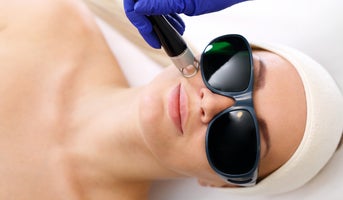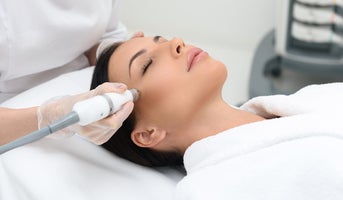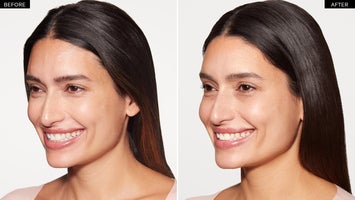Collagen stimulation: How to restore collagen in your face
What is collagen?
What does collagen do for your face and skin?
What causes collagen loss in our face as we age?
What causes collagen loss in our face when we lose weight?
How do collagen and elastin in your skin work together?
External factors that cause collagen loss in our face
Collagen Injectable: What is Sculptra®?
Other collagen treatments for your face
Are you starting to notice signs of aging in your skin, like thinning or sagging? Or changes to your face during or following weight loss, like sagging or loose skin? Maybe you've heard that collagen can make skin look younger and firmer. But what exactly is collagen, and how does it help renew your skin?
If you're wondering how to restore collagen in the face and want to achieve firmer, more youthful-looking skin, here’s the lowdown on collagen stimulating treatments, tips on how to prevent collagen loss, and ways to stimulate the body’s natural production of collagen to get firmer, thicker, and natural skin.
What is collagen?
Collagen is a fibrous protein that provides strength and structure to various parts of the body, including bones, muscles, tendons, and the middle layer of the skin (the dermis).1 It acts like the building blocks of your skin, forming a supportive network that helps maintain its firmness and elasticity.2
Under a microscope, collagen appears as tightly bound fibers, similar to stacked logs or twisted ropes.3 This strong structure is key to keeping skin firm and youthful.1-3


What does collagen do for your face and skin?
A large part of our bodies is composed of collagen, making up at least 70% of the dry weight of our skin.3 Collagen is a structural protein that is more abundant when we are younger, however, collagen production naturally decreases with age - about 1% a year after the age of 20 - and skin starts to lose volume, leading to wrinkles and skin laxity.4,5
What does collagen do to our looks? A healthy supply of collagen in the face and skin is key to a youthful-looking complexion.6 It's no surprise that collagen stimulating treatments are popular in aesthetics since they can help to boost natural collagen production, helping to improve skin firmness.6-8
What causes collagen loss in our face as we age?
As we age, our body’s natural collagen production decreases.5 The cells in our body that produce collagen, called fibroblasts, are no longer able to produce it as efficiently as they once did, and existing collagen becomes fragmented, bent, and frayed.9
As the skin ages, the natural collagen loss leads to thin skin and structurally weakened skin.10,11 Other typical signs that collagen loss can have in the aging face are sagging skin and loose skin.4,5
Find out more about what happens with natural collagen in our skin as we age.

What causes collagen loss in our face when we lose weight?
Rapid weight loss can also impact the levels and distribution of collagen and elastin in the skin on your face.12
When you lose weight, your face may also be losing some of the tissue that once stretched and cushioned your skin. Additionally, when people lose weight, or they lose weight rapidly, the collagen in their skin can become damaged.12
This loss of collagen, alongside a loss of elasticity, and loss of fat pads, can impact your skin in similar ways that aging can, by causing areas that are loose and sagging.12–14
Find out more about collagen loss in your face after weight loss.
How do collagen and elastin in your skin work together?
Both collagen and elastin are found in the middle layer of your skin and both contribute to skin health and structure.15
Elastin makes up the main component of elastic fibers in your skin, which is important for skin elasticity and its ability to stretch. Elastin, like collagen, is an important protein in your skin and if elastin fibers are damaged, either by age or other factors, like weight loss, then skin can lose its elasticity and skin integrity. A reduction of collagen and elastin together in the skin contributes to the formation of wrinkles, sagging, and loose skin.15
External factors cause collagen loss in our face
Collagen loss isn’t just age-related or linked to weight loss. UV radiation from the sun significantly reduces collagen, smoking also speeds up skin aging by impairing collagen production and breaking down existing collagen.16,17 Additionally, high sugar intake damages collagen through a process called glycation, weakening its strength and elasticity, often dubbed the "sugar sag."18,19
Therefore, to maintain collagen levels, consider your lifestyle, and habits, and, if necessary, make appropriate changes. Here are a range of lifestyle changes you could make to help prevent collagen loss and restore collagen in the face naturally:
How to prevent collagen loss
Minimize sun exposure and wear sunscreen:16,20
Excessive UV radiation can greatly reduce collagen production, leading to thick wrinkles and sagging skin. To protect your skin, wear a broad-spectrum sunscreen with SPF 30 or higher to block both UVA and UVB rays. Additionally, seek shade and wear protective clothing to further minimize sun exposure and slow down collagen loss.
Quit smoking: 17,21–23
Smoking accelerates aging by damaging your collagen and promoting chronic inflammation. The toxins in cigarette smoke restrict blood flow, narrowing blood vessels, limiting the delivery of oxygen and nutrients to your skin. Quitting not only helps prevent further collagen loss but also improves skin elasticity and overall complexion, restoring a more youthful appearance.
Cut back on sugar: 18,19
A high-sugar diet can speed up collagen breakdown through a process where sugar binds to collagen, forming harmful compounds that weaken its structure. This leads to stiffer fibers, sagging skin, and loss of elasticity. Reducing sugar intake can help protect collagen and keep your skin firm and youthful. Focus on a diet rich in antioxidants, like fruits, vegetables, and whole grains, to help stimulate collagen production in the skin.
Hydration is key:11
Drinking plenty of water (aim for at least 8 glasses a day!) helps keep your skin hydrated and supports collagen structure. Skin hydration affects its elasticity, which is linked to collagen levels.
Get enough sleep:24
Not getting enough sleep can impact collagen production, which is essential for keeping your skin and mucous membranes healthy. When you’re sleep-deprived, your skin’s protective barrier may weaken, and your immune system can become less effective. This is important because a healthy immune response plays a role in collagen production.
Manage stress levels:25
Chronic stress leads to increased levels of cortisol, which in turn can accelerate collagen breakdown and negatively impact skin health. Stress management techniques, like mindfulness and meditation, can positively impact skin health by reducing stress hormones that may contribute to collagen loss.
Other facial changes as we age
Apart from aging skin, with increased skin laxity and sagging skin, or structurally weakened and thin skin, there are other facial changes that come with age. Collagen loss, bone remodeling, and fat redistribution all contribute to changes that result in a less youthful appearance.12,13
More reading: Why a collagen treatment can address several signs of aging
Collagen biostimulators: What is Sculptra®?
Sculptra® is an injectable collagen and elastin biostimulator treatment that activates the skin’s ability to produce new, fresh collagen.26,27 As a collagen biostimulator, Sculptra® is not a collagen injectable or collagen filler. Collagen injections or collagen fillers don’t provide the same long-lasting results as biostimulators.28
Instead of collagen, Sculptra® contains microspheres of poly-L-lactic acid, PLLA-SCA™. PLLA-SCA™ is a biodegradable substance that has been proven safe and has been used in medical implants and dissolvable sutures for more than 30 years.29,30 Biodegradable means that the PLLA-SCA™ can be broken down and eliminated by the body.
Sculptra is injected into the deeper layers of the skin. In the skin, the PLLA-SCA™ microspheres stimulate the skin’s own natural collagen production, helping to reinforce the skin’s inner structure and increase facial volume that has been lost. 27,29,31
The effect of collagen biostimulators has been tested and investigated in many clinical trials over many years. In one study, the effectiveness and safety of Sculptra® was compared to human-derived collagen injections for treating nasolabial fold wrinkles in 233 patients.28
Results showed that Sculptra® maintained over 86% improvement at 25 months, while human-derived collagen dropped from 96% improvement at three weeks to just 6% at 13 months.28
Patient opinions and satisfaction scores for Sculptra® also remained high, at 81% by month 25, compared to 15% for human-derived collagen.28
As a collagen biostimulator, Sculptra® therefore provides a much more long-lasting benefit compared to traditional collagen fillers, and this is reinforced by clinical evidence.28
Sculptra® was approved in 1999 for aesthetic use in the European market and is FDA approved in the United States.32-34
Other collagen treatments for your face
Many collagen treatments for your face are not about adding collagen but about rebuilding or helping to naturally stimulate collagen production in your skin. If you want a more visible effect on sagging skin or reduced skin laxity, you may want to explore some of these facial collagen treatments.
There are several aesthetic treatments that can boost collagen in the face by encouraging skin renewal. Some examples of commonly used collagen stimulation treatments include:

Chemical peels:
Strategically remove skin layers by applying chemical solutions, stimulating the skin's natural regeneration process.35
Intense pulsed light (IPL), radiofrequency (RF) and lasers:
Controlled skin-wounding techniques that involve selectively heating dermal collagen to trigger protein denaturation and stimulate a regenerative response.35


Autologous Platelet-Rich Plasma (PRP):
PRP is extracted from whole blood and works by activating fibroblasts. This process may stimulate collagen synthesis and other matrix components.35
Injectable skin renewal treatments that stimulate collagen production

In the 25-month study, as many as 86% of those treated with Sculptra® continued to show improvement up to at least 25 months after the last treatment (the study ended after 25 months).16
When patients themselves were asked to rank the results, 80% rated Sculptra® as “good” to “excellent” 25 months after the last treatment.17
In the 12-month study, patients exhibited a significant increase of skin thickness. They were also very satisfied – 100% would recommend Sculptra® to a friend.27
Skin insights
EXPLORE GALDERMA’S EXCLUSIVE PORTFOLIO OF AESTHETIC TREATMENTS
Tailored for personalized results to enhance your individual beauty. Be like no other. Be uniquely you.
Are you looking for a clinic?
REFERENCES
- Shoulders MD, Raines RT. Annu Rev Biochem. 2009;78(1):929-58.
- Zhang S, Duan E. Cell Transplantation (2018);27(5):729-738
- DermNet®. Collagen. 2023. https://dermnetnz.org/topics/collagen. Accessed September 25, 2024.
- Fisher GJ, Varani J, Voorhees JJ. Arch Dermatol. 2008;144(5):666-72.
- Shuster S, Black M et al. British Journal of Dermatology (1975) 93, 639
- Huth S, et al. J Drugs Dermatol. 2024 Apr 1,23(4): 285-288
- Fabi S, et al. Poster presented at the IMCAS World Congress. 26–28 January 2023. Paris, France
- Hexsel D, et al. Dermatol Surg. (2020);46(8):1122–1124
- Quan T, et al. J Invest Dermatol. 2013;133(3):658-67.
- Farage MA, et al. Adv Wound Care (New Rochelle). 2013;2(1):5-10.
- Palma L, et al. Clin Cosmet Investig Dermatol. 2015;8:413-21.
- Sami K, et al. Eplasty. 2015;15:e4.
- Boswell CB. Mo Med. 2010;107(3):189-94.
- Cabbabe SW. Mo Med. 2016;113(3):202-6.
- Baumann L, et al. Aesthet Surg J Open Forum. 2021;3(3):ojab019.
- Mukherjee S, et al. Clin Interv Aging. 2006;1(4):327-48.
- Overbeek SA, et al. PLoS One. 2013;8(1):e55612.
- Danby FW. Clin Dermatol. 2010;28(4):409-11.
- Nguyen HP, Katta R. Skin Therapy Lett. 2015;20(6):1-5.
- Gromkowska-Kępka KJ, et al. J Cosmet Dermatol. 2021;20(11):3427-31.
- Lahmann C, et al. Lancet. 2001;357(9260):935-6.
- DermNet®. Smoking and its effects on the skin. 2023. https://dermnetnz.org/topics/smoking-and-its-effects-on-the-skin. Accessed October 11, 2024.
- Doshi DN, et al. Arch Dermatol. 2007;143(12):1543-6.
- Carpenter S. The effects of sleep deprivation on your skin. Open Access Government. 2021. https://www.openaccessgovernment.org/the-effects-of-sleep-deprivation-on-your-skin/110335/. Accessed September 24, 2024.
- Dunn JH, Koo J. Dermatol Online J. 2013;19(6):18561.
- Sculptra Aesthetic IFU. Galderma. Available from: https://www.galderma.com/us/sites/default/files/2020-11/782347%20Sculptra%20Aesthetic%20IFU.pdf.
- Goldberg D, et al. Dermatol Surg. 2013;39(6):915-22.
- Brandt FS, et al. Aesthet Surg J. 2011;31(5):521-8.
- Stein P, et al. J Dermatol Sci. 2015;78(1):26-33.
- Lowe NJ. J Eur Acad Dermatol Venereol. 2006;20 Suppl 1(s1):2-6.
- Moyle GJ, et al. HIV Med. 2004;5(2):82-7.
- FDA. Summary of safety and effectiveness data. Available at: https://www.accessdata.fda.gov/cdrh_docs/pdf3/ p030050s002b.pdf. Accessed (2022 Nov).
- Galderma. Data on file (MA- 54151).
- Galderma. Data on File (MA-46589).
- Ganceviciene R, et al. Dermatoendocrinol. 2012;4(3):308-19.
[10.03.205] | [GL-RES-2400220]






